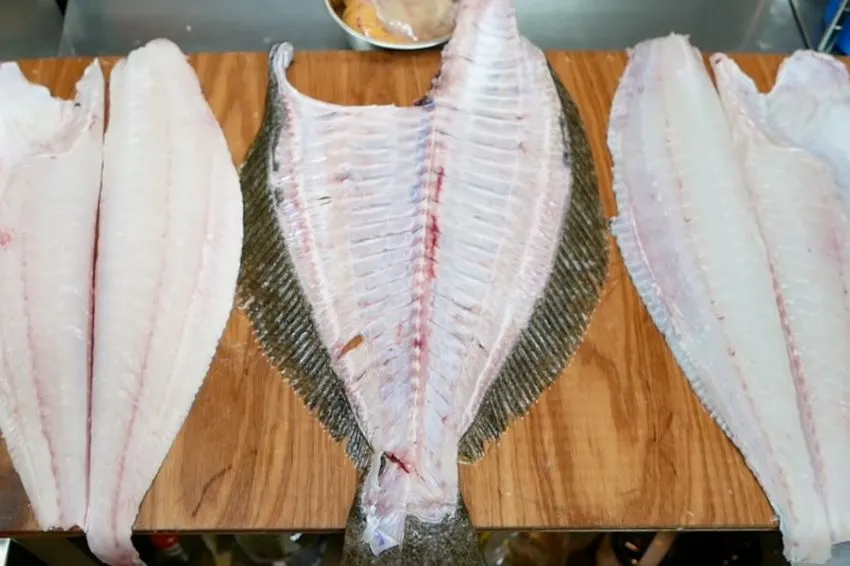Halibut is a popular fish that many people around the world enjoy. It is a flatfish found in the North Atlantic and North Pacific oceans. Halibut is a versatile fish that can be cooked in many different ways, including grilling, baking, and frying.
However, some wonder if halibut can be eaten raw, like sushi.
Can You Eat Halibut Raw?
Halibut can be eaten raw, but some essential things must be remembered. First, it is crucial to ensure that the halibut is fresh and appropriately handled. Raw fish can contain harmful bacteria and parasites that can make you sick if improperly handled.
Raw halibut has a mild, sweet flavor and a delicate texture that can be enjoyed in sushi, sashimi, and ceviche dishes. However, it is essential to note that consuming raw fish carries a risk of foodborne illness.
Raw halibut should be frozen for at least seven days at -4°F (-20°C) before consumption. This process will kill any parasites that may be present in the fish.
It is also important to source your halibut from a reputable supplier that follows proper handling and storage procedures. Freshness is vital when consuming raw fish, so use your senses to determine whether the fish is safe to eat.
When preparing raw halibut, it is essential to use clean utensils and cutting boards to avoid cross-contamination with other foods. Consuming the fish as soon as possible after thawing is also recommended to ensure its quality and safety.
Health Benefits of Raw Halibut

As a seafood lover, I have always been curious about the edibility of raw halibut. In this section, I will explore raw halibut’s nutritional value and taste profile.
Raw halibut is an excellent source of protein, with a 3.5-ounce serving containing about 20 grams of protein.
It also contains omega-3 fatty acids essential for maintaining good heart health.
Additionally, raw halibut is rich in vitamins B12 and D and minerals such as selenium and phosphorus.
What does Raw Halibut taste like?
Raw halibut has a mild, sweet flavor similar to the taste of raw cod or flounder.
The texture is firm and meaty, with a slightly chewy mouthfeel.
However, it is essential to note that not all halibut is suitable for raw consumption.
Pacific halibut is generally considered safe to eat raw. In contrast, Atlantic halibut may contain parasites and should be cooked thoroughly before consumption.
Potential Risks of Eating Raw Halibut
As much as I love eating raw fish, I always be aware of the potential risks involved.
Raw Pacific Halibut can harm your health if not handled and prepared correctly. Below are some risks you should be aware of before consuming raw halibut.
Parasites
Raw Pacific Halibut may contain parasites that can cause foodborne illnesses. These parasites can cause symptoms such as nausea, vomiting, diarrhea, and fever. In severe cases, they can lead to hospitalization and even death.
It is important to note that not all parasites can be killed by freezing or cooking. Therefore, it is essential to consume raw halibut that has been adequately inspected and handled.
Foodborne Illness
In addition to parasites, raw Pacific Halibut may contain harmful bacteria that can cause foodborne illnesses. These microorganisms can cause symptoms such as nausea, vomiting, diarrhea, and fever.
The most common foodborne illnesses associated with raw fish include Salmonella and Vibrio. It is essential to properly clean and prepare the fish before consuming it raw to reduce the risk of foodborne illness.
To minimize the risk of foodborne illness and parasites, it is essential to always purchase fresh, high-quality raw halibut from a reputable source. Additionally, it is necessary to properly clean and prepare the fish before consuming it raw, which includes removing any bones and skin and thoroughly washing the fish with cold water.
It is also recommended to freeze the fish for at least 24 hours before consuming it raw to kill potential parasites. By taking these precautions, you can safely enjoy the delicious taste of raw Pacific Halibut without risking your health.
Cooked vs. Raw Halibut
As an avid seafood enthusiast, I have tried both cooked and raw halibut. While both have their unique flavors and textures, there are some key differences to consider.
Taste Comparison
Regarding taste, cooked halibut has a mild, sweet flavor with a delicate, flaky texture. The cooking process enhances the fish’s natural sweetness and gives it a slightly nutty flavor.
On the other hand, raw halibut has a clean, fresh taste with a firmer texture. It has a subtle sweetness and a slightly salty flavor reminiscent of the ocean.
Nutritional Comparison
Regarding nutrition, both cooked and raw halibut are excellent sources of protein, omega-3 fatty acids, and various vitamins and minerals. However, cooking halibut can cause a slight loss of nutrients, particularly vitamin B12 and vitamin D.
On the other hand, raw halibut is an excellent source of enzymes and amino acids that can aid digestion and support overall health.
FAQ
Here are some frequently asked questions about the edibility of halibut raw and a guide to enjoying it safely.
Yes, it is safe to eat halibut raw if it is handled and prepared properly. However, it is important to note that consuming raw fish comes with some risks, such as bacterial infections and parasitic infections. Therefore, it is crucial to follow the guidelines for preparing and storing raw fish.
When preparing halibut for raw consumption, it is important to start with fresh, high-quality fish. The fish should be cleaned and filleted properly, removing any bones and skin. It is recommended to freeze the fish at -4°F (-20°C) for at least 7 days or at -31°F (-35°C) for at least 15 hours to kill any parasites that may be present.
There are many ways to enjoy halibut raw. One popular way is to prepare it as sashimi, which involves thinly slicing the fish and serving it with soy sauce, wasabi, and pickled ginger. Another way is to prepare it as ceviche, which involves marinating the fish in citrus juice and serving it with avocado, cilantro, and other ingredients.





Leave a Reply
You must be logged in to post a comment.